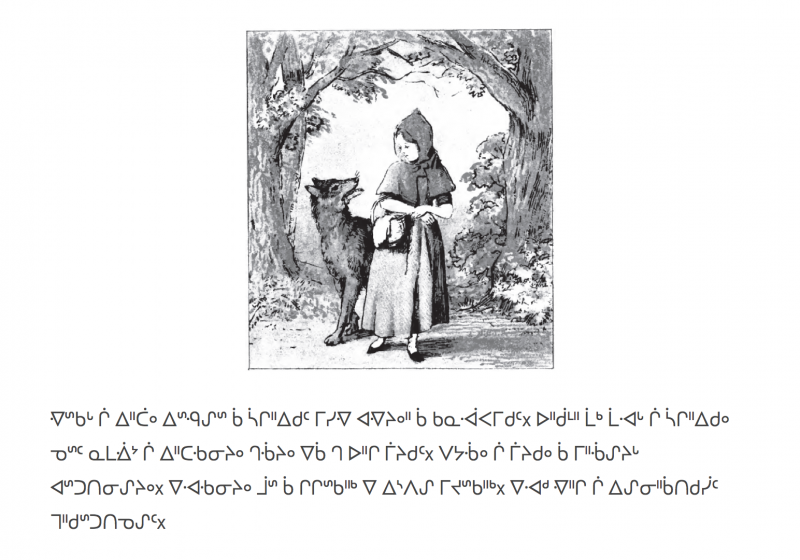
Scan of a page of the Cree translation of Pilgrim’s Progress published in 1886. Courtesy – Kevin Brousseau.
Storytelling plays an important role in cultures around the world, helping to pass knowledge from generation to generation. The universality of this tradition is reflected in the similarities of the central themes and characters in some stories across cultures and languages. Thanks to the power of translation, tales from one part of the world can find their way into the homes of families on the other side of the world.
Blogger and Cree language digital activist Kevin Brousseau noticed that traditional Cree stories had been translated into English, but not the other way around as other well-known stories were not available in Cree. He said in an interview with Rising Voices:
After translating the Little Red Riding Hood and Hansel and Gretel, I realized that elderly monolingual speakers of Cree had never heard of these stories! As I read my stories to my elderly grandmother, I was struck by how much she enjoyed them, but also how closely these stories resembled Cree stories once they were read aloud in Cree.
So began his desire to make these popular stories available to more people through his blog Cree Language. So far, Brousseau has translated popular fairy tales such as Goldilocks and the Three Little Pigs, as well as some of Aesop's Fables in both the Southern East Cree and Moose Cree dialects.

Screenshot of the first part of Little Red Riding Hood translated into Southern East Cree by Kevin Brousseau
Cree is the most widely spoken native language in Canada, and is comprised of various dialects. It is an official language of the Northwest Territories, and recognized as a minority language in five provinces. According to the 2006 Canadian Census, there are approximately 120,000 speakers across the different dialects.
On his blog, he also writes original stories in the Cree language, translates into and from the Cree language, and shares insight about the language's grammar, dialects, lexicon, and the various orthographies. When he is not blogging, he works as the Cree Language Coordinator for the Cree Nation Government in Quebec.
When it comes to its presence on the Internet, Kevin has noticed that the Cree language has significantly increased online over the past few years, but Cree citizen media is “still in its infancy.” In addition to his blog, he cites various online projects that are working to promote the language, such as Cree Literacy, a network that promotes Cree language and cultural literacy. Another blog called âpihtawikosisân is written by a Plains Cree-speaking Métis woman living in Montreal. Little Cree Books is an online project that seeks to publish free texts in the Plains Cree dialect, all of which are available under a Creative Commons license.
On social media, there are several Facebook groups that share resources, teach basic words or phrases, or act as a space where people can communicate in the Cree language. And on Twitter, the hashtags #speakcree and #nêhiyawêtân can be found from time to time. Kevin himself tweets at @_Kepin_ sharing encouraging words to others wanting to share the language.
Don't forget to #SpeakCree to one another & to your children today. Let's keep our language alive! #Nehiyaw #Nehiyawêtâw #Nehiyawêwin #Cree
— Kevin Brousseau (@_Kepin_) March 13, 2015
Despite this increase in the availability of content in different dialects of the Cree language, communities still face challenges especially when it comes to the unique writing, also called syllabics, in the language on the web. He said:
There are whole sets of characters that simply do not display properly if the website does not support the appropriate fonts. That is definitely a problem for bloggers such as myself. Although the proper fonts are selected as I draft my posts, another person’s computer may lack the fonts and as a result my blog will simply not display properly on his or her computer. This is a nuisance that often keeps people from even attempting to write in Cree online.
The relatively low numbers of people that read and write in the language is one of the major challenges, but the increase in the number of online resources and content can help encourage more people to explore communicating in the Cree language.
Overall, response to the year-old blog has been positive. The blog primarily focuses on the written language, and in comparison to some Cree language sites, Kevin primarily writes in the language, instead of writing about the language. As a result, the audience for written Cree is still relatively low due to the low number of Cree-literate Internet users. However, he hopes to add more multimedia to the project through audio clips. He cites one example of how the translations found on his blog are now being used for educational purposes:
A lady from a neighbouring community was pretty excited about my Cree translation of the 3 Little Pigs and asked if she could use it in her community as a teaching resource. My hope is that more people take an interest in learning how to read our language – in the meantime, my blog will keep growing.


